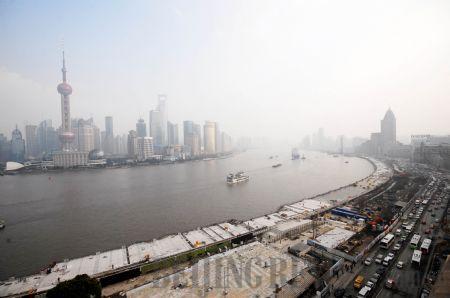|
 |
|
A NEW LOOK: The reconstruction of the Bund will take on a new look to greet the opening of 2010 Shanghai World Expo (XINHUA) |
A reopening ceremony of the Bund in Shanghai held on March 28 marked the completion of a three-year renovation of the famous tourist destination.
Taking on a spectacular brand-new look, the Bund is ready to embrace about 70 million visitors to the 2010 World Expo that will begin on May 1.
The renovation included the installation of a bronze "Shanghai Bull," a sculpture created by Italian-American sculptor Arturo Di Modica, the designer of Wall Street's "bull" in the United States.
A new "financial belt" has also been built as part of the local government's plan to make the Bund the financial center of Shanghai.
"The Bund is the symbol of our city," Shanghai Mayor Han Zheng said at the ceremony. "It has witnessed China's tremendous social and economic transformation since it was established as a port 170 years ago." While maintaining its traditions and culture, the renewed Bund will lead the way in changing the economic functions on both sides of the Huangpu River area, he added.
'Financial belt'
The newly built "financial belt" on the Bund will be home to modern service businesses centered on financial sector, according to the mayor. Economists also expect the "financial belt," which has a 2.6-square-km land area and 4.6-million-square-meter build-up area, to lead the transformation of the local economic growth pattern.
In 2009, a document issued by the State Council, China's cabinet, stated that Shanghai would be developed into an international financial hub. If Shanghai's overall blueprint to that end were compared to a game of chess, the "financial belt" would be the most critical piece on the board, said Zhou Wei, governor of the Huangpu District in the city.
Shanghai is the birthplace of China's modern financial and shipping industry. As early as 1849, British merchants opened the ship line from Shanghai to Hong Kong. The first bank on China's mainland was set up in Shanghai in 1897. By the early 20th century, the city was as famous as London, Paris and New York, having been dubbed "the No.1 hub in the East."
With this historical and economic background, Shanghai is an ideal place to nurture the modern financial industry, where the "financial belt" will serve as an engine.
Influenced by the global recession, many financial institutions have scaled back their overseas expansion plans. The Huangpu District is thus looking to the emerging financial services sector as a new growth point. It aims to develop three major businesses in the "financial belt," namely asset management, capital investment and financial services. It will also try to attract institutions and agencies doing non-banking business, such as securities, trusts and market evaluation.
Underground network
The new Bund also includes a key project of an underpass dug under the 33 century-old buildings featuring various Western styles. Together with the newly built Xinjian Road Tunnel and Renmin Road Tunnel, it forms an underground network that links the "financial belt," the north Bund's shipping center and Pudong's Xiaolujiazui financial center.
"The network will not only divert some of the heavy traffic along the Bund underground, but also increase the city's overall economic strength by connecting its three fast-rising areas," said Yu Hongsheng, Director of the Urbanization Research Center under the Shanghai Academy of Social Sciences.
Fantastic facilities
Like Wall Street and London's financial area, the Shanghai Bund will bring in high-end consumer facilities to create "a pleasant and convenient environment." There are already world-class hotels like the Peninsula, time-honored department stores like the Bund 18, and large shopping malls housing numerous luxury brands like Chanel and Gucci. More commercial, hospitality and entertainment conglomerates are flocking to the Bund.
"We aspire to build a 'Wall Street in the east' and Shanghai's 'Avenue des Champs-Élysées' on the Bund," said Zhou.
Construction of many other "people-oriented" projects is about to start in an effort to attract multinationals and high-caliber talent to the Bund.
These projects include underground corridors connecting office buildings in the Shanghai Bund International Financial Center; well-equipped apartment buildings for lease on this expensive piece of land; international schools, hospitals and exclusive clubs; and a 4,600-square-meter finance-themed square with landmark sculptures and electronic screens displaying instant financial information.
Local officials will also cooperate with international insurance giants to provide medical insurance to foreigners working on the Bund.
(Source: Xinhua News Agency) |